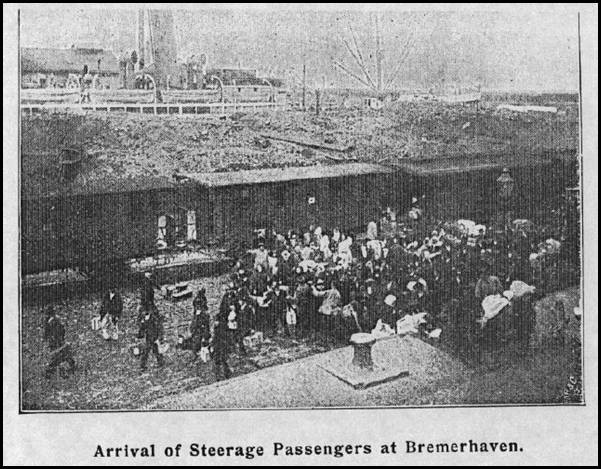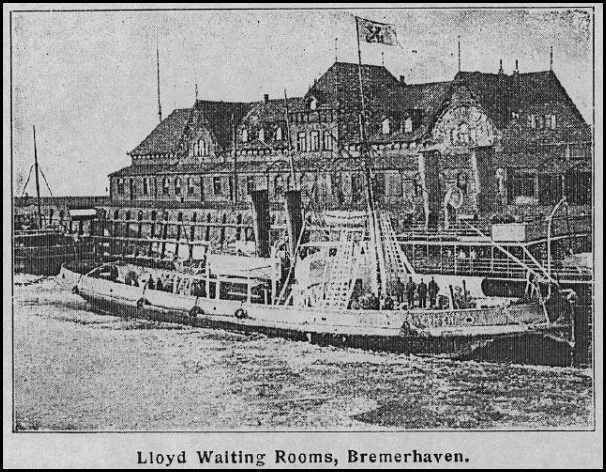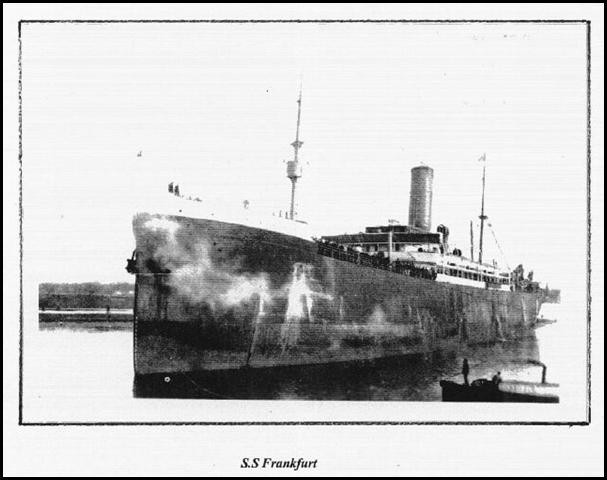5. Subbotniki Emigrate to America
Much of Russia was in turmoil in the years leading up to and after the 1905 revolution. Life in Georgia (the home of Joseph Stalin) where many Subbotniki were living was especially chaotic. Many Molokans who were also in the area were departing for a new home in America following a prophecy. They were escaping the military draft that was in full force to support the Russo-Japanese War. It is not surprising that the Subbotniki followed the Molokans to Los Angeles during this dangerous time.The Subbotniki followed many of the same migration routes as the Molokans. Some entered the United States at Ellis Island via Antwerp, Belgium, assisted at times by Jewish relief agencies. Others traveled via Bremen, Germany to Galveston, Texas on the North-Lloyd German steamship line.

Photo copied from North-Lloyd German Steamship Line brochure.
Courtesy of Steamship Historical Society of America Library, Baltimore
One such Subbotniki family leaving Russia during this period was that of my great grandfather Vasily Makarich Pivovaroff and his wife Maria Samarin. Vasily’s family, eighteen in number, traveled with a larger Subbotnik group of about thirty people. First they traveled to Bremerhaven (Bremen), Germany by train. There they boarded the SS Frankfurt operated by the North German-Lloyd Shipping Company.

Photo copied from North-Lloyd German Steamship Line brochure.
Courtesy of Steamship Historical Society of America Library, Baltimore.
New York City was becoming overcrowded with immigrants from many countries. An American-Jewish agency initiated a program to disperse immigrants to cities other than New York. Under this program, ships of the North German-Lloyd line were chartered to transport Russian Jews to the port of Galveston, Texas instead of Ellis Island. After the first few trips, the organizers received many complaints about poor living conditions aboard the ships. Jewish passengers found that the German crew members were rude to emigrants in general, and to their group in particular.
Investigators inspected the Frankfurt in Bremerhaven on August 22, 1907 just before its sailing with Vasily Pivovaroff’s group. The Frankfurt sailed from Bremerhaven on August 24, 1907 with 1,400 passengers. The Pivovaroffs traveled in steerage class — so called because, in those days, the accommodations for the lowest paying passengers were located below deck at the level housing the ship's steering mechanism. These were the poorest accommodations on board.

Photo copied from North-Lloyd German Steamship Line brochure.
Courtesy of Steamship Historical Society of America Library, Baltimore.
On this sailing with the Pivovaroffs the Frankfurt arrived in Galveston, Texas on September 14, 1907.

Photo courtesy of Steamship Historical Society of America Library, Baltimore, Maryland
An American doctor was aboard the next Westbound sailing of the Frankfurt on October 24. His reports were summarized in the book, Galveston: Ellis Island of the West, written by Bernard Marinbach in 1983:
The first sight of the cramped
steerage quarters was enough to depress
anyone who saw it. ... Some 180 persons ... [would] have to lie close
to and over one another in a single cubicle for three weeks. .... Many
passengers have the feeling of being fed almost like cattle.... The
present arrangements (and the steerage as a whole) are unworthy of
human beings.
Except for beer, no refreshments were sold in the steerage compartment, ostensibly to prevent members of the crew from embezzling food products and selling them to the passengers. Thus, the steerage passengers were totally dependent on the meals which they received in the dining hall.
There were no kosher cooking facilities on board until a few years later. Until then, the only kosher meat available came packaged in tin cans.
The passage to Galveston has indeed the drawback of being longer than the passage to New York.
The straw bags that serve as mattresses are put in white cases at the beginning of the journey, but are removed a few days before reaching {the interim port of } Baltimore, so that the passengers to Galveston have to sleep during ten or twelve days on uncovered straw bags. In consequence, I would hear the people complain: 'We are treated like cattle!' After their having been used to cover bedding, the removal of the cases makes a still worse impression.
Except for beer, no refreshments were sold in the steerage compartment, ostensibly to prevent members of the crew from embezzling food products and selling them to the passengers. Thus, the steerage passengers were totally dependent on the meals which they received in the dining hall.
There were no kosher cooking facilities on board until a few years later. Until then, the only kosher meat available came packaged in tin cans.
The passage to Galveston has indeed the drawback of being longer than the passage to New York.
The straw bags that serve as mattresses are put in white cases at the beginning of the journey, but are removed a few days before reaching {the interim port of } Baltimore, so that the passengers to Galveston have to sleep during ten or twelve days on uncovered straw bags. In consequence, I would hear the people complain: 'We are treated like cattle!' After their having been used to cover bedding, the removal of the cases makes a still worse impression.
From Galveston, Vasily Pivovaroff and his family were transported to nearby Houston. From there, they continued on to California by train. Upon reaching Los Angeles, they settled among their Molokan cousins and friends in the Flats district, just east of downtown near the river and railroad yards. Some of the Subbotnik children of Vasily’s brother, Traphim Makarich Pivovaroff, also came to America and lived nearby.
Back to Subbotniki.net